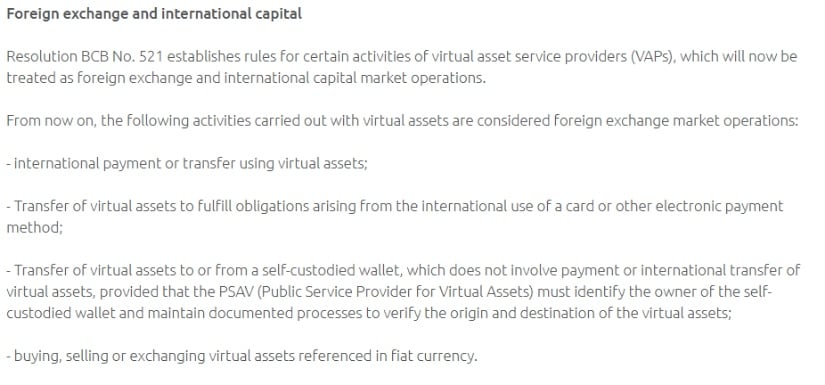On a Monday as mundane as a teacup without saucer, November 10, 2025, the Banco Central do Brasil, with all the flair of a peacock at a pigeon party, unveiled three resolutions (519, 520, and 521) destined to metamorphose the crypto landscape. These edicts, my dear reader, drag stablecoin transactions into the same regulatory ballroom as the waltz of Brazilian reais and US dollars. How utterly divine! 🕺💸
Why This Matters for Brazil’s Crypto Carnival
Ah, Brazil, the land of samba and stablecoins! Between mid-2024 and mid-2025, this tropical titan processed a staggering $319 billion in crypto transactions, securing its place as the fifth-largest crypto market globally, according to the ever-watchful Chainalysis. But the true pièce de résistance? A whopping 90% of this crypto frenzy involves stablecoins-those digital darlings pegged to mundane currencies like the US dollar, used more for payments than for speculative shenanigans. 🌍💰
The new rules, you see, address a concern as pressing as a poorly timed sneeze at a symphony. Gabriel Galipolo, the central bank’s maestro, declared in February 2025 that 90% of Brazil’s crypto activity was stablecoin-driven, a trend he found “significant and worrying.” Oh, the horror! Not of the technology itself, mind you, but of how these digital darlings have been used to sidestep financial oversight with all the subtlety of a rhinoceros at a tea party. 🦏☕

Stablecoins, with their faster and cheaper transactions, are the belle of the financial ball. Yet, they’ve also been linked to tax evasion and money laundering-a scandalous affair indeed! By treating them as foreign exchange operations, Brazil aims to close regulatory loopholes while preserving the allure of digital payments. How very practical! 🔒💳
New Licensing Follies and Capital Capers
Enter the “Sociedades Prestadoras de Serviços de Ativos Virtuais” (SPSAVs), a license so grand it requires a breath to pronounce. Any crypto company daring to operate in Brazil must secure this treasure from the central bank. But beware! The capital requirements are as steep as a mountain of macarons-10.8 million reais ($2 million) at the very least, with some ventures demanding up to 37.2 million reais ($7 million). A far cry from the 1-3 million reais originally whispered in public consultations. 🏦💼
These licensed entities must dance to the same tune as traditional financial institutions, with consumer protection, anti-money laundering controls, and reporting systems so detailed they’d make a librarian blush. The goal? To bring crypto firms under banking-level scrutiny without smothering innovation. A delicate balance, indeed! ⚖️✨
Transaction Limits and Self-Custody Shenanigans
Under this new regime, every stablecoin purchase, sale, or international transfer becomes a foreign exchange operation-even your daily coffee paid in digital dollars! Transactions with unlicensed foreign companies are capped at $100,000, a move as cunning as a fox at a henhouse, preventing large sums from slipping through traditional channels unnoticed. 🦊🚫
Self-custody wallets, those rebellious rogues, are not exempt. When a licensed provider is involved, companies must identify wallet owners and trace asset origins and destinations. Anti-money laundering rules now extend to corners once shrouded in regulatory shadow. Yet, Brazil stops short of banning self-custody wallets outright-a nod to user freedom, albeit with a watchful eye. 🔍🔐
Implementation Timeline and Industry Intrigue
Mark your calendars, darlings! The rules take effect on February 2, 2026, with existing companies given nine months to comply or face the regulatory guillotine. Foreign firms must establish local operations under Brazilian law, a move as inevitable as a hangover after Carnival. 🗓️⚔️
By May 4, 2026, licensed companies must submit monthly reports to the central bank, detailing client information, asset types, amounts in reais, and counterparty relationships. Bernardo Srur, president of the Brazilian Association of Cryptoeconomy (ABCripto), called the framework “positive and necessary” but lamented the high capital requirements and tight compliance timeline. A tale as old as time: the struggle between innovation and regulation. ⏳📊
Global Glamour and Future Flourishes
Brazil’s approach places it at the forefront of stablecoin regulation, a move as bold as a sequined gown at a black-tie affair. This comes as nations worldwide scramble to establish crypto frameworks, inspired by the US GENIUS Act earlier this year. 🇧🇷🌟
The regulations align with Brazil’s broader financial strategy, making stablecoin transfers visible in official balance-of-payments data. The central bank gains insight into money flows once hidden from economic statistics-a victory for transparency, if not for secrecy. 🕵️♂️📉
And let’s not forget the “RESBit” plan, a proposal to allocate $19 billion toward purchasing Bitcoin as a strategic asset, akin to hoarding gold reserves. Brazil, it seems, is not just regulating crypto-it’s embracing it with open arms and a keen eye for opportunity. 💎🚀
The message is clear: crypto is welcome in Brazil’s financial system, but it must play by the same rules as traditional money. This approach could inspire other Latin American countries to follow suit, creating a regulatory dance that balances innovation with oversight. 🌎💃
The Digital Real Revolution
These regulations are more than just crypto oversight; they’re a step toward a digital financial system as sleek as a samba dancer’s moves. Brazil has positioned itself as a leader in crypto regulation, addressing concerns about financial stability and consumer protection without stifling innovation. As the world watches, these rules may become the blueprint for the global digital economy. 🌐🎉
Read More
- EUR USD PREDICTION
- USD GEL PREDICTION
- EUR ZAR PREDICTION
- TRUMP PREDICTION. TRUMP cryptocurrency
- SUI PREDICTION. SUI cryptocurrency
- Brent Oil Forecast
- EUR IDR PREDICTION
- FIL PREDICTION. FIL cryptocurrency
- XMR PREDICTION. XMR cryptocurrency
- USD CAD PREDICTION
2025-11-12 03:39